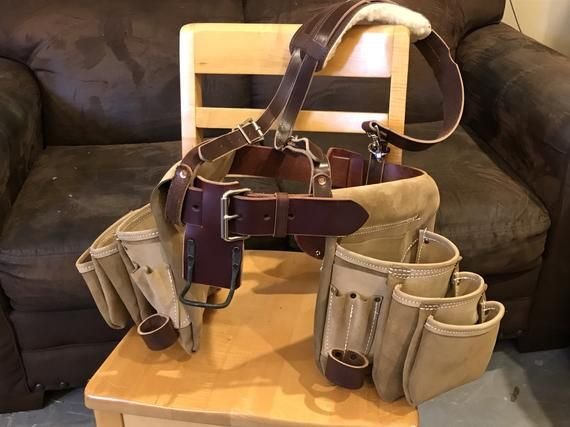In various professions, the efficiency and organization of one’s tools are paramount to success. A well-designed tool belt serves as an indispensable accessory, ensuring that essential instruments are within immediate reach, thereby enhancing productivity and workflow. For professionals such as carpenters, electricians, and gardeners, the convenience of having tools readily accessible cannot be overstated. A leather tool belts not only streamlines tasks but also minimizes downtime, allowing for seamless transitions between different activities. Moreover, the ergonomic distribution of weight provided by a quality tool belt reduces physical strain, contributing to better posture and overall comfort during extended periods of work.

Among the various materials available, leather stands out as a superior choice for crafting tool belts. Renowned for its exceptional durability, leather can withstand the rigors of demanding work environments, offering longevity that synthetic materials often fail to provide. Its natural resistance to wear and tear ensures that a leather tool belt remains a reliable companion over the years. Beyond functionality, leather exudes a timeless aesthetic appeal, adding a touch of professionalism and sophistication to the user’s attire. As leather ages, it develops a unique patina, enhancing its visual charm and reflecting the character of its user. This combination of resilience and elegance makes leather tool belts a preferred choice for professionals seeking both practicality and style in their work gear.
Types of Leather Tool Belts
1. Single-Pouch Belts
Ideal for light-duty tasks, single-pouch leather tool belts provide a compact and convenient solution for carrying essential tools. These belts are perfect for DIY enthusiasts, handymen, or professionals who require minimal tools on hand. They offer ease of movement and prevent unnecessary bulk, making them a great choice for quick jobs.

2. Multi-Pocket Belts
Designed for professionals who need multiple tools at their fingertips, multi-pocket leather tool belts feature various compartments for organization. These belts allow workers such as carpenters and electricians to carry hammers, screwdrivers, pliers, and other essentials efficiently. Their structured layout enhances accessibility, reducing downtime and boosting productivity.

3. Suspender-Style Belts
For those handling heavy tools for extended periods, suspender-style leather tool belts provide superior weight distribution. The built-in suspenders help alleviate strain on the lower back and hips, offering greater comfort during long work hours. These belts are ideal for construction workers, mechanics, and tradespeople engaged in demanding tasks.

4. Specialized Belts
Crafted to meet the specific needs of different trades, specialized leather tool belts are tailored for electricians, carpenters, plumbers, and more. These belts come with custom compartments designed for trade-specific tools, ensuring easy access and maximum efficiency. They provide a practical, professional, and organized solution for industry experts.

Top U.S. Companies Offering Leather Tool Belts
1. Rex Tool Bags (rextoolbags.com)
Founded by a union carpenter in 2018, Rex Tool Bags specializes in high-quality, customizable leather tool belts for various trades. Their products focus on durability, functionality, and user comfort, making them a preferred choice for professionals. With tailored designs, these belts enhance efficiency and provide a long-lasting solution for heavy-duty work.
2. Bolt Belts (boltbelts.com)
Bolt Belts is known for premium leather tool belts that blend durability with style. Their collection includes belt sets, pouches, and bags, all designed to offer superior organization and accessibility. The company also provides customizable options, catering to the specific needs of tradesmen and construction workers.
3. Filson (en.wikipedia.org)
With a legacy dating back to 1897, Filson is a trusted name in rugged outdoor gear, including leather tool belts. Designed for harsh conditions, their belts are built to last, making them a popular choice among professionals who require reliable, long-lasting work gear. Filson’s commitment to craftsmanship ensures superior quality in every product.
4. Tandy Leather Factory (en.wikipedia.org)
Tandy Leather Factory operates over 100 stores worldwide, offering a vast selection of leather products and supplies. They provide materials and DIY kits for individuals looking to craft or customize their own leather tool belts. Their range caters to both hobbyists and professionals seeking high-quality leather solutions.
5. Bianchi International (en.wikipedia.org)
Based in Temecula, California, Bianchi International is a leading manufacturer of leather goods for law enforcement and industrial use. Their heavy-duty leather belts are designed for durability and strength, making them an excellent option for professionals who demand tough, long-lasting work gear.
Key Features to Consider
1. Material Quality
The durability and longevity of a leather tool belt depend on the type of leather used. Full-grain leather is the highest quality, offering superior strength and aging beautifully over time. Top-grain leather, while slightly processed, still provides durability and a smooth finish. Choosing the right material ensures resilience against daily wear and tear.
2. Stitching and Rivets
High-quality stitching and reinforced rivets are essential indicators of a well-crafted tool belt. Double-stitched seams and heavy-duty rivets prevent fraying and tearing, ensuring long-term reliability. Strong reinforcement at stress points enhances the belt’s ability to carry heavy tools without damage.
3. Adjustability
A well-fitting tool belt improves comfort and efficiency. Look for belts with adjustable straps, multiple sizing options, and padded sections for better weight distribution. A customizable fit prevents discomfort and strain during long work hours, making it easier to move freely.
4. Tool Accessibility
An efficient layout is crucial for quick and easy tool retrieval. Well-designed pouches, loops, and compartments allow professionals to organize their tools systematically. A functional belt minimizes downtime and enhances workflow, ensuring that essential tools are always within reach.
Benefits of Using Leather Tool Belts
1. Durability
Leather tool belts are built to withstand heavy use, making them a long-lasting investment for professionals. The natural toughness of leather resists wear, tear, and environmental conditions, ensuring reliability over years of rigorous work.
2. Comfort
Unlike synthetic materials, leather offers natural flexibility and breathability, molding to the user’s body over time. This enhances comfort, reduces strain during extended work hours, and allows for ease of movement while carrying tools.
3. Professional Appearance
Leather tool belts exude a polished and sophisticated look, making them ideal for professionals who value presentation. Their timeless aesthetic enhances credibility and professionalism, especially in client-facing jobs.
4. Customization
Many leather tool belts come with detachable pouches, loops, and add-ons, allowing users to tailor them to their specific needs. This adaptability ensures better organization and efficiency, making the belt a versatile tool for various trades.
Maintenance Tips for Leather Tool Belts
1. Regular Cleaning
Dirt and debris can cause premature wear, so it’s essential to clean your leather tool belt regularly. Use a damp cloth to wipe off dust and grime, and for deeper cleaning, apply a mild leather cleaner to maintain its appearance and longevity.
2. Conditioning
Leather can dry out and become brittle over time, so applying a leather conditioner helps maintain its suppleness. Conditioning prevents cracking, keeps the leather soft, and enhances its natural durability, ensuring long-term performance.
3. Proper Storage
Store your leather tool belt in a cool, dry place away from direct sunlight and moisture. Excess heat or humidity can lead to fading, cracking, or mold growth, reducing the belt’s lifespan and affecting its quality.
4. Avoid Overloading
Exceeding the belt’s weight capacity can stretch the leather and weaken the stitching. Keep only essential tools in the belt to maintain its shape, prevent unnecessary stress, and extend its durability for long-term use.
Conclusion
Investing in a high-quality leather tool belt is a smart decision for professionals who value durability, comfort, and efficiency. Unlike synthetic alternatives, leather tool belts offer long-lasting reliability, a professional appearance, and the ability to customize for different trades. With proper maintenance, they can serve as a dependable companion for years.
Before purchasing, it’s essential to assess individual needs and choose a belt that fits the job’s demands. Whether it’s a single-pouch belt for light work or a multi-pocket option for extensive tool organization, selecting the right belt enhances productivity. Consider the top companies mentioned for high-quality, reliable options to ensure you get the best value for your investment.
Recommended blog for update
Leather Sandals
(FAQ)
1. Why choose a leather tool belt over synthetic materials?
Leather tool belts are more durable, flexible, and aesthetically appealing compared to synthetic alternatives. They last longer and provide better weight distribution, reducing strain during extended use.
2. How do I determine the right leather tool belt for my profession?
Consider the number of tools you carry daily, the weight distribution, and comfort. For light tasks, a single-pouch belt is ideal, while professionals needing multiple tools should opt for a multi-pocket or suspender-style belt.
3. How often should I clean and condition my leather tool belt?
Regular cleaning should be done weekly with a damp cloth, while conditioning should be applied every few months to maintain flexibility and prevent cracks.
4. Can I customize my leather tool belt?
Yes, many leather tool belts allow customization with additional pouches, loops, and suspenders to fit specific job requirements. Some manufacturers even offer tailored designs for professionals.
5. What is the best way to store a leather tool belt?
Store it in a cool, dry place away from direct sunlight and moisture. Hanging it properly or placing it in a dust-free environment helps maintain its shape and quality.

